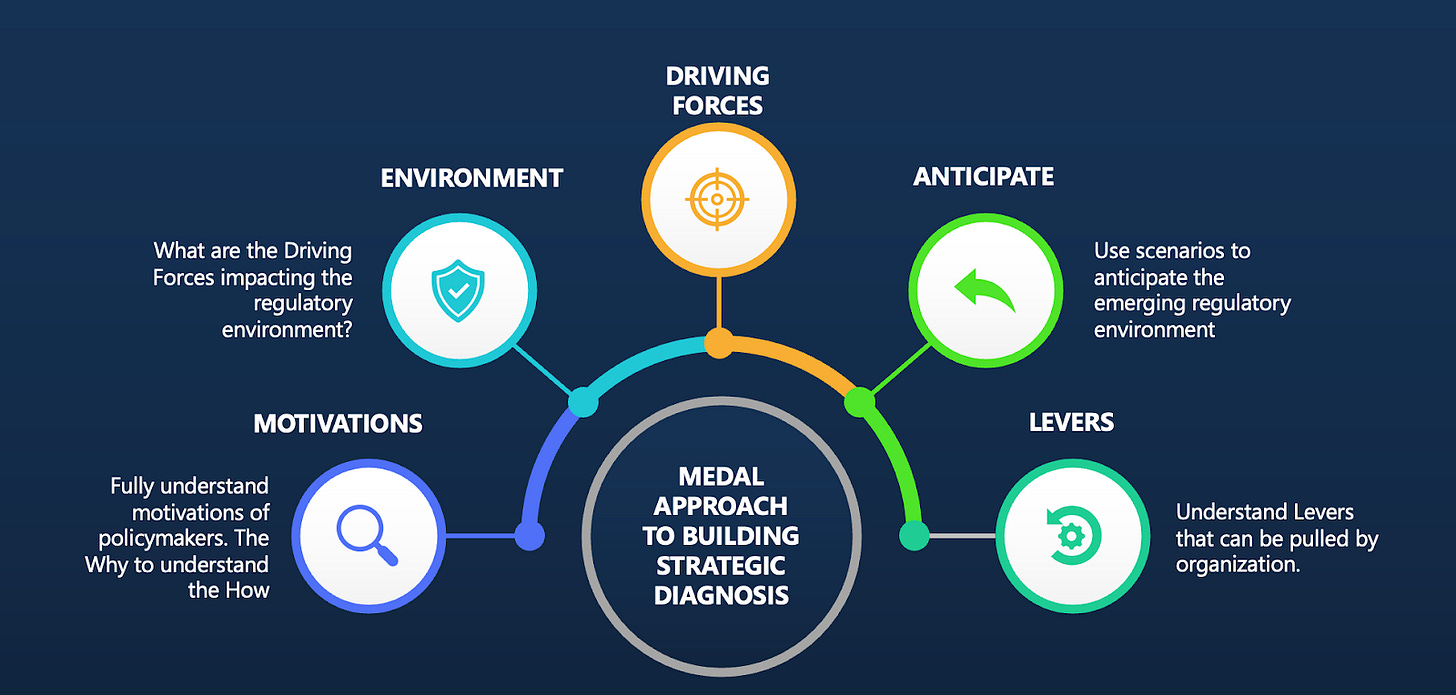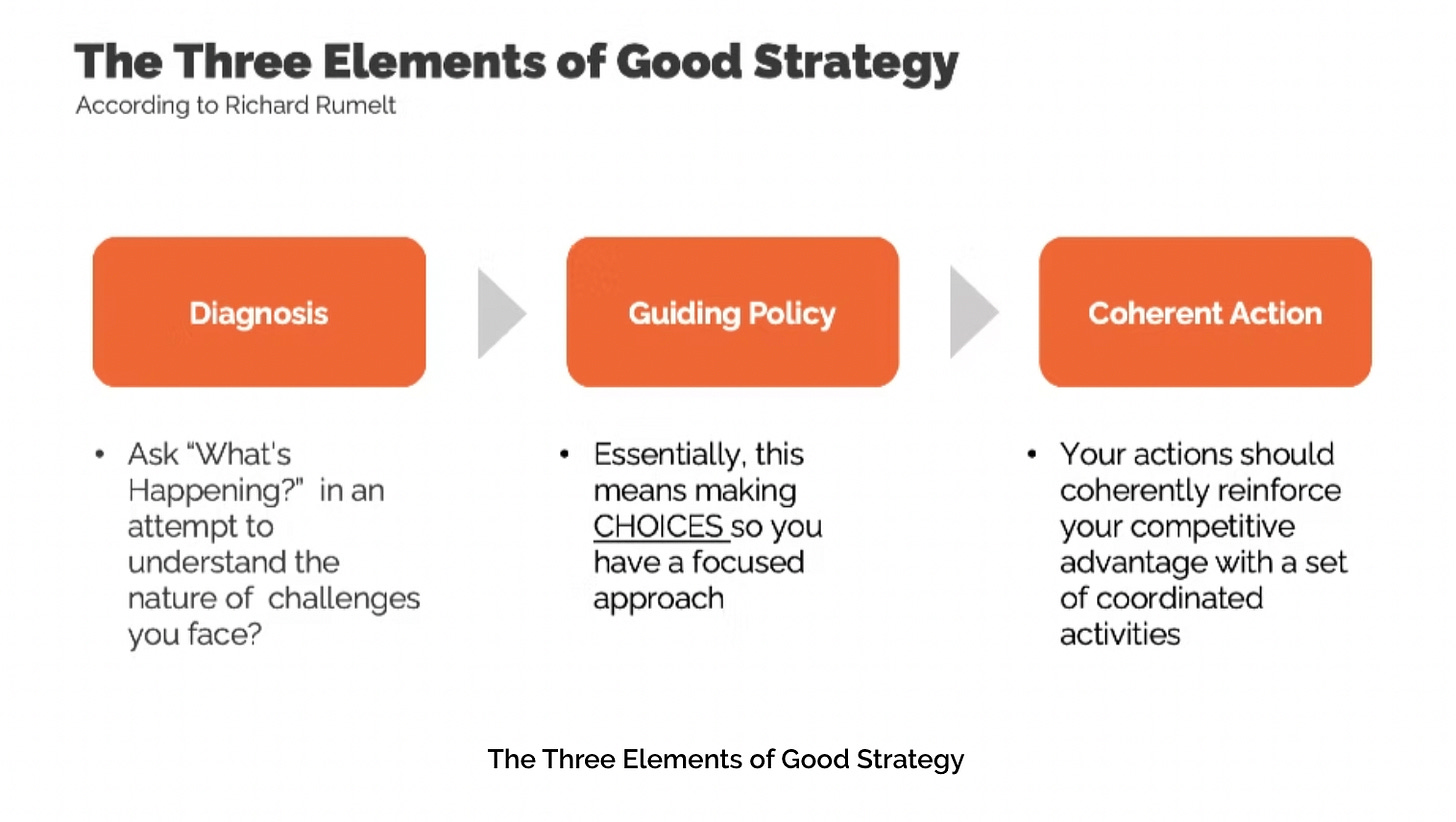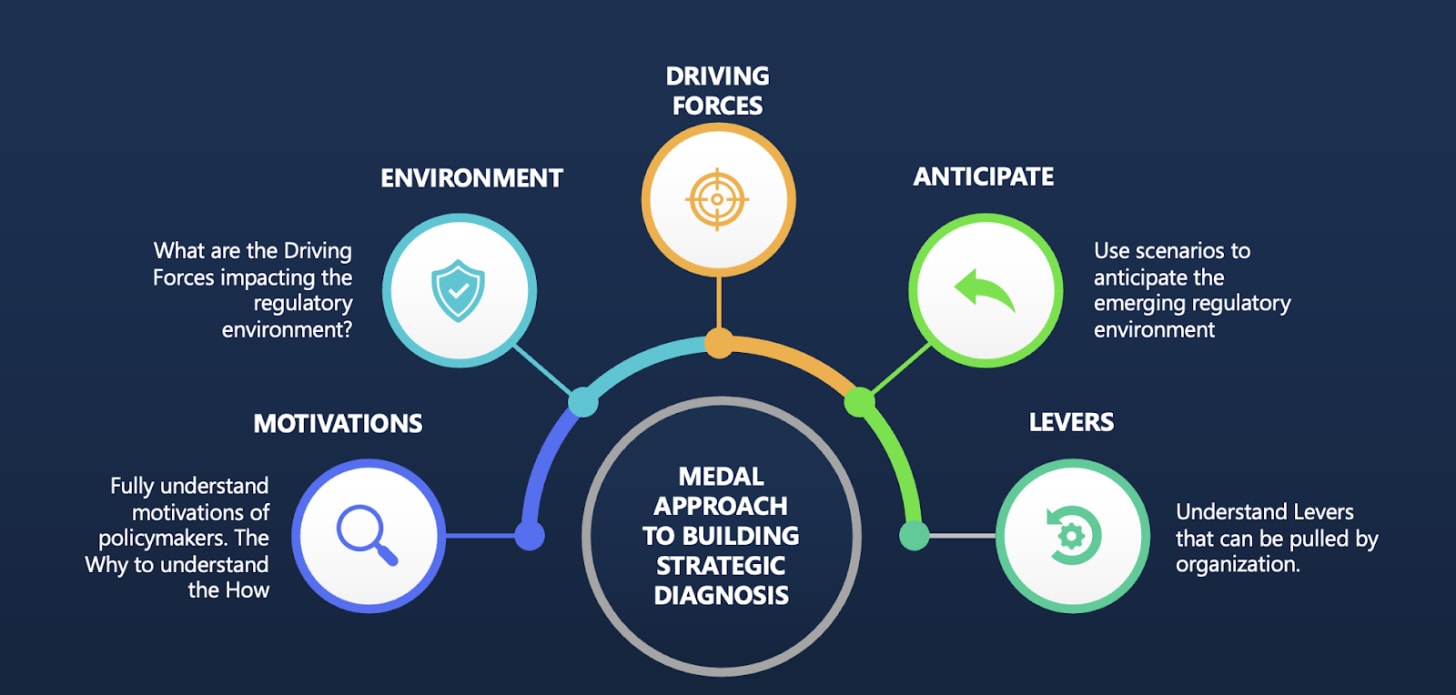IP33 - What is going on here? The most important strategic question for public policy professionals.
Using the MEDAL approach to develop a proper strategic diagnosis
Public policy or government relations is now a fundamental part of any company’s business strategy. Regulation can knock a company’s strategy completely off course, rendering key strategic goals impossible and delivering substantial hits to a company’s bottom line. To take just one example, under the EU’s Digital Markets Act fines can reach 20 per cent of a company’s global turnover. And regulation will also have a key impact on product strategy.
In these circumstances, the government relations or public policy functions within an organisation must be considered essential strategic functions within a business. Just as important, public policy professionals have to be tooled up to think and act in a strategic way and have the correct methodologies to enable this.
Public policy strategy must be effectively designed, rather than merely representing a wishlist of aspirations. And this should be accompanied by ensuring that all actions are geared and structured around a well-designed public policy strategy.
As public policy aligns with political uncertainty, I’d like to consider how public policy professionals can best answer the “what is going on here” question, enabling them to respond more effectively to regulatory challenges and political shocks. I’ll use Rumelt’s definition of what makes for Good Strategy and then propose what I call the MEDAL methodology for helping to diagnose the strategic environment for regulation and public policy.
This involves addressing:
Policymaker’s Motivations;
The Strategic Environment;
The Driving Forces within the environment and how they might impact regulation;
Anticipating the scenarios that the environment might result in;
The Levers that an organisation can pull. And what is out of its control.
The elements of good strategy
One of my favourite books about strategy is Richard Rumelt’s Good Strategy, Bad Strategy. Rumelt, a doyen of Harvard Business School talks from his experience of seeing corporate strategies that are good, bad and indifferent. Rumelt called bad strategy a “social contagion”, which he says has been on the rise over the past three decades. For him, a bad strategy is simply a wishlist about where company performance should be, rather than a thorough analysis of how to solve a problem or the challenges that a company might face. As he set out in a McKinsey interview:
Many companies treat strategy as a way of presenting to the board and to the investing public their ambitions for performance, and they confuse that with having a strategy… Executives end up saying, “Our strategy is to achieve these results,” but that is not strategy… Strategy is problem-solving. It is how you overcome the obstacles that stand between where you are and what you want to achieve. There are, of course, companies and individuals with brilliant insights into what’s happening in the world and how to adapt to or take advantage of it, but I am often asked to participate in strategy sessions, and a lot of them are awfully banal. In a typical session, the CEO will announce certain performance goals: “We want to grow this fast, and we want to have this rate of profitability.” Maybe they will throw out some things about safety and the environment, and that’s their strategy. But that’s not a strategy—that’s a set of ambitions.
If that is bad strategy, what, then, is good strategy? For Rumelt, the essence of a good strategy has three elements and three key questions - what he calls a kernel:
A diagnosis. Addressing the question “what is going on here?” A thorough analysis of the nature of the strategic environment in which a company will be operating, as well as understanding the critical factors to be addressed. Given that, Rumelt sees strategy as primarily an exercise in problem solving and understanding how to remove obstacles in the way of corporate goals, it’s this diagnosis stage that can be the most important element of a strategy. As I’ll come on to, in business and in government relations, it is often the most neglected.
A guiding policy. Addressing the question “how will the issue/ problem be approached?” This sets the parameters for action and provides a framework to ensure that a strategy is shaped by a coherent policy, rather than a sprawling set of choices.
Coherent actions. Addressing the question, “how will the strategy be executed to ensure impact and delivery?” These actions should be specifically linked to the guiding policy and should reinforce each other.
As such, a strategy should be about properly understanding the scale of challenges and problems, making difficult choices and focusing resources on the most important challenges. So what does this all mean for government relations?
All of this is nicely explained in this Strategy Kiln diagram:
Getting the diagnosis right. Why this is essential for Public Policy professionals
In recent years, as public policy and regulation have made an ever greater impact on business priorities and business goals, it has sometimes been difficult to simply deal with the flood of new regulations that are impacting business strategy. The “firefighting” of dealing with immediate regulatory threats can be all consuming, meaning that getting through the regulatory storm becomes the absolute focus and considering how the strategic environment might emerge is seen as a luxury at best.
But in government relations, as in broader business strategy, ignoring the “diagnosis’ element of a strategy can render any public policy strategy to be anaemic and ineffective. Purely concentrating on dealing with the problems of today can mean that bigger problems are being stored up for the future and root causes are ignored.
Ignoring the potential changes in a strategic environment limits a company’s room for manouvere and the potential for proactivity. It can also mean that a company is consistently responding or reacting, rather than making the pace. This is particularly challenging in an environment where regulation often leads to a political appetite for further regulation.
As such, it’s essential for public policy practitioners to properly address the “what is going on here” question and to fully understand the various forces that are shaping the environment in which a public policy strategy will be formulated.
A strategic approach to public policy - a MEDAL approach
Getting the “diagnosis” element of strategy right is essential for public policy practitioners. And that means using a methodological approach to considering the strategic environment. I’ve called such an approach the MEDAL approach - based on Understanding Motivations; the Strategic Environment; the Driving Forces; Anticipation of what is next via scenarios; and the Levers that organisations can pull. Each of these elements is essential to getting the diagnosis right. And only by getting the diagnosis right can public policy professionals develop a robust public policy strategy.
Understanding Motivations
Regulation and legislative challenges do not occur in a vacuum. They occur because of political pressures, business pressures and societal pressures on the political environment. It’s essential to understand what is motivating regulators and politicians and what they hope to achieve from regulation. For example, could they be looking to restore sovereignty or domestic power? Is their priority to grow the national economy? Or to protect domestic suppliers? It’s only possible to understand the How element of regulation if you stand back and analyse the Why.
Understanding the Environment
The broader environment in which regulation is made is essential to properly comprehend and analyse. Tools such as PESTLE, which consider various “driving forces” by category (in this case Political, Environmental, Social, Technological, Legal and Environmental) can be invaluable in helping to consider the broader strategic environment.
Understanding the Driving Forces
All of these driving forces aren’t equal, of course. Some might well be incidental or diminishing in importance, whilst others might be accelerating. Some might have a substantial impact on the operations of a business, whilst others could only have marginal impact. A thorough analysis of the driving forces should consider which of these are accelerating and which of them are most likely to have considerable regulatory impact. Tools such as a Futures Wheel can be used to better consider the potential impact of various driving forces and the potential interaction between these driving forces can also be analysed in a structured way.
Anticipating what’s next. Building Scenarios.
Regular readers of this newsletter will know that I’m a big fan of scenarios when done properly. And they are most successful when genuinely shifting mental maps and encouraging participants to think about the future differently. Conversely, scenarios are at their least effective when they merely extrapolate existing thinking a few years into the future, or simply act as predictions, rather than as the product of a thorough methodology. Effective scenarios will build a variety of potential future models, all of which should be taken equally seriously.
Late last year, the OECD produced a fascinating paper about the importance of organisations using foresight methodologies, such as scenarios, to “help countries identify and characterise global emerging critical risks.” As they put it:
The methodology emphasises understanding risks “at source,” focusing on vulnerabilities, interconnectedness, and possible management strategies. Rather than predicting a single future, it seeks to broaden the range of possibilities, encouraging proactive adaptation, building collective understanding, and ultimately strengthening government capacity to navigate and shape an increasingly complex and uncertain global risk landscape.
The same argument should apply to public policy practitioners. Stepping back from the day to day of firefighting and using scenarios to test potential future policy environments represent an important way of testing institutional agility, readiness and potential gaps.
An effective scenario exercise will also identify “alarm bells” - considering what the signs are that a certain scenario is becoming more likely and what an organisation should do in that case.
Identifying Levers and Blind Spots
By undergoing a thorough diagnosis of the strategic environment, public policy professionals can then move on to the next two steps - building a guiding policy and coherent actions. Once you understand the problem that you are solving and the challenges facing the organisation, you are better placed to understand the actions that can be taken to maximise comparative advantage. At this point, it’s crucial to understand which levers an organisation can pull to impact the regulatory environment and which factors are outside of its control. This makes it possible to identify the most impactful actions that can flow from the strategic exercise. In particular:
What are the levers that can be pulled now to make a best case scenario more likely and a worst case scenario less likely?
What are the gaps that can be filled to make potential actions more impactful?
Which elements are outside of an organisation’s control? Are there any actions that an organisation can take to cover weak spots? This might include building alliances or increasing visibility around key areas.




